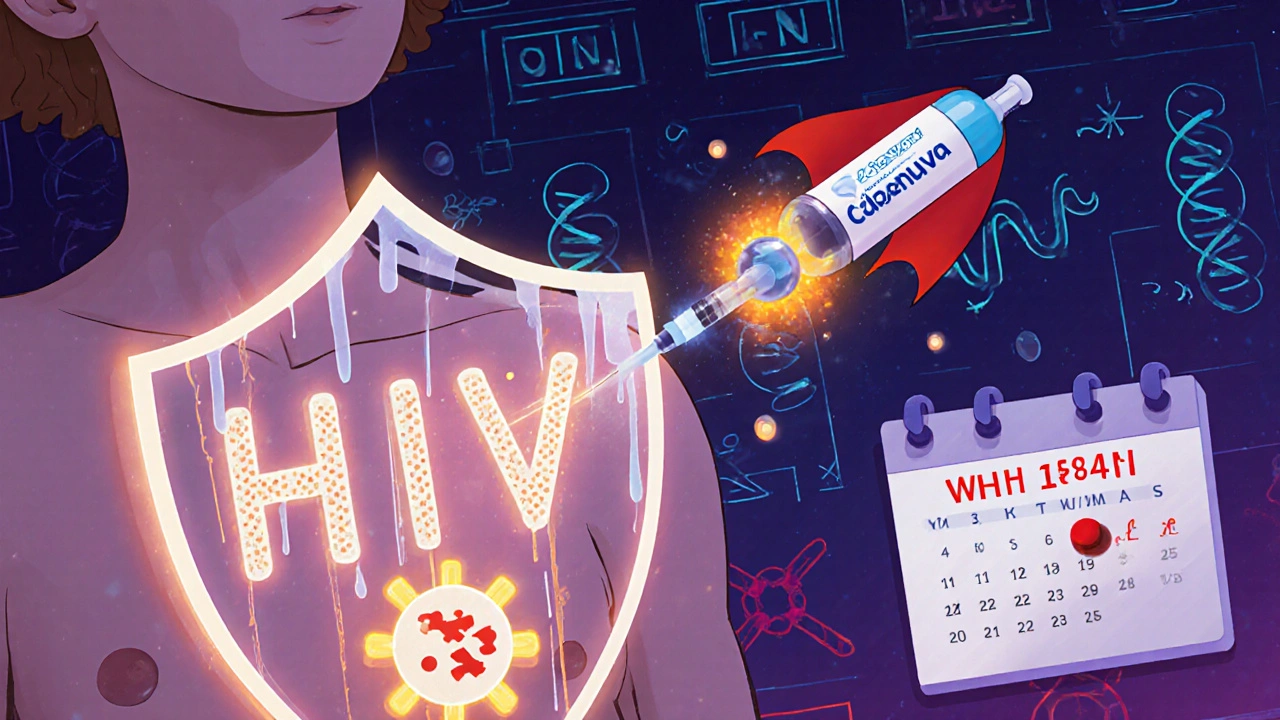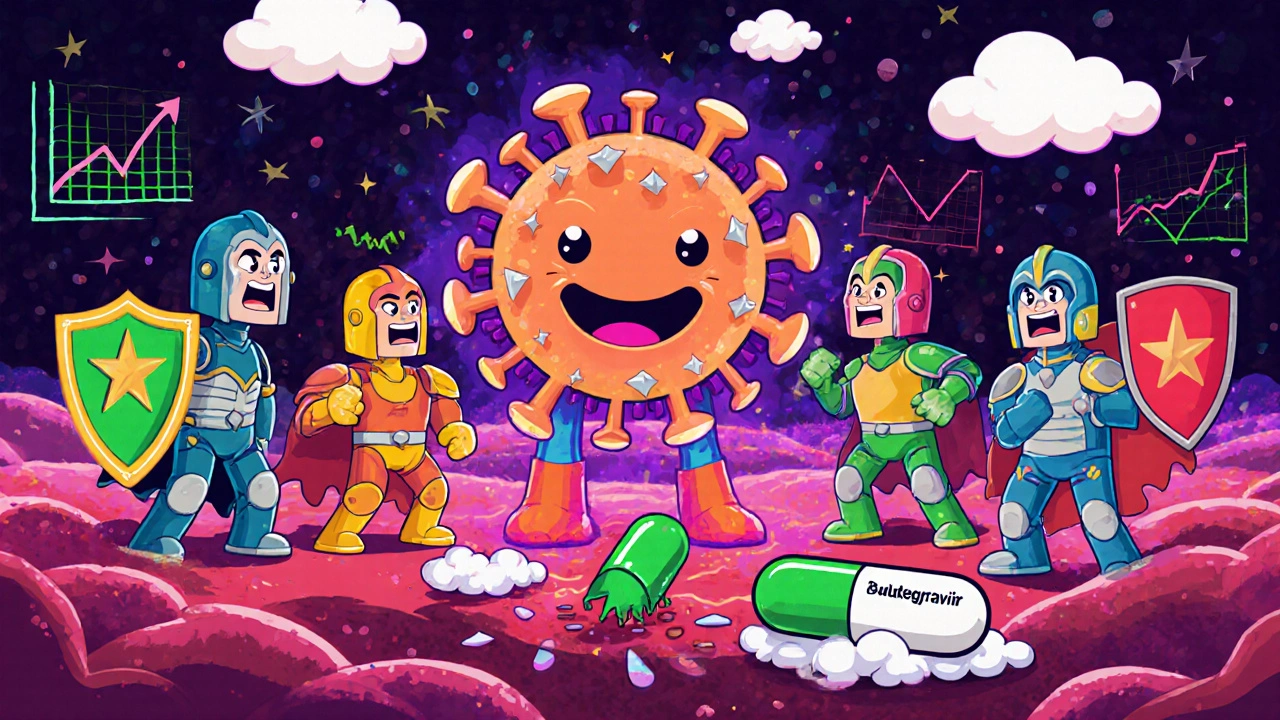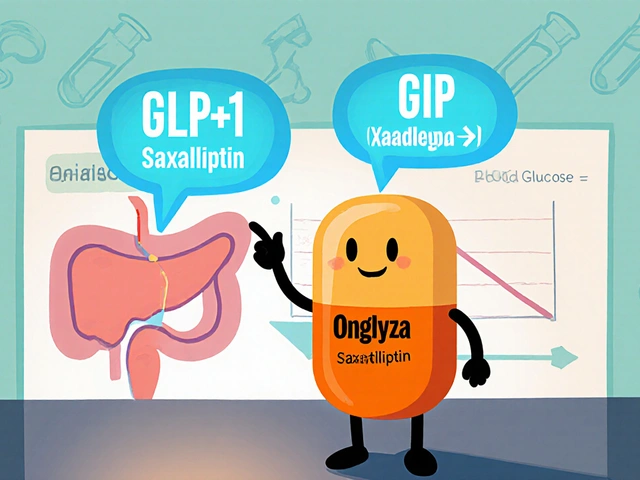How HIV Medications Work - and Why They Can Fail
Antiretroviral therapy (ART) doesn’t cure HIV. But when taken correctly, it stops the virus from multiplying so well that the viral load drops to undetectable levels - under 50 copies per milliliter. At that point, the person can’t transmit HIV to others, their immune system recovers, and life expectancy matches that of someone without HIV. That’s the promise of modern treatment. But behind that success is a complex battle between drugs, the virus, and the human body - one where mistakes, interactions, and mutations can undo years of progress.
The Six Classes of HIV Drugs and How They’re Used Today
There are six main classes of antiretroviral drugs, each targeting a different stage of HIV’s life cycle. The most common first-line regimens today combine two NRTIs with either an INSTI, NNRTI, or boosted PI. NRTIs like tenofovir and emtricitabine act as faulty building blocks that stop the virus from copying its DNA. INSTIs like dolutegravir and bictegravir block the virus from inserting its genetic material into human cells - and they’re now the gold standard because they’re harder for HIV to resist.
NNRTIs like doravirine work differently: they bind to the reverse transcriptase enzyme and change its shape. Newer ones like doravirine are more forgiving than older drugs like efavirenz, which caused nightmares for many users - insomnia, dizziness, and depression. Protease inhibitors, though still used, require boosting with ritonavir or cobicistat, which increases their risk of interacting with other medications. The other classes - fusion inhibitors and CCR5 antagonists - are reserved for complex cases where other drugs have failed.
Why Drug Interactions Are a Silent Threat
Most people with HIV take more than five other medications - for cholesterol, blood pressure, depression, or pain. That’s where things get dangerous. Boosted PIs, for example, can spike the levels of statins like simvastatin by up to 8 times, leading to muscle damage or kidney failure. Midazolam, a sedative, becomes dangerously strong when mixed with boosted PIs. Even common supplements like St. John’s wort can drop ART levels so low that resistance develops.
Some drugs are outright banned together. The Liverpool HIV Interactions Database lists 12 major drug classes that can’t be safely combined with boosted PIs. Clinicians rely on tools like the NIH’s HIV Drug Interaction Checker - used over a million times a year - to avoid these traps. But in rural clinics, access to these tools is limited. One survey found 63% of providers in small towns struggle to get resistance testing within 30 days, let alone check for interactions in real time.
Resistance Isn’t Just About Skipping Doses
People think resistance happens because someone misses a pill. That’s true - but it’s not the whole story. HIV mutates constantly. Even with perfect adherence, the virus can develop resistance if the drug doesn’t reach high enough levels in tissues like lymph nodes or the brain. That’s why tenofovir alafenamide (TAF) replaced tenofovir disoproxil fumarate (TDF) in most new regimens: TAF works at 90% lower doses because it concentrates better in immune cells, reducing kidney and bone damage.
Some mutations are predictable. The M184V mutation knocks out lamivudine and emtricitabine, but it also makes HIV less fit to replicate. K65R affects tenofovir and abacavir. NNRTI resistance often starts with a single mutation like K103N - which wipes out efavirenz but leaves doravirine still effective. INSTIs are the toughest to beat. Dolutegravir needs multiple mutations to lose power. But even it’s not invincible. New mutations like R263K plus G118R are now showing up in people who’ve failed multiple regimens.
Real Stories Behind the Numbers
On Reddit’s r/HIV, users share how side effects derail treatment. One person stopped Atripla because efavirenz made them too anxious to sleep. Their viral load climbed. Another took Truvada for PrEP but still got infected - testing revealed the M184V mutation, meaning the virus was already resistant before they even started. These aren’t rare cases. A 2024 survey of over 3,000 people found 22% had to switch regimens due to resistance or side effects. Bone pain from TDF affected 41% of those switching. Neuropsychiatric issues from efavirenz hit 37%.
On the flip side, people on dolutegravir-based regimens like Biktarvy or Dovato report almost no side effects. Ninety percent say they never missed a dose because they didn’t feel sick. Long-acting injectables like Cabenuva (monthly shots of cabotegravir and rilpivirine) are changing the game. In trials, 94% of users preferred shots over pills. But 12% quit because of painful injection sites. And here’s the new risk: if you miss an injection, drug levels drop slowly over months - giving HIV time to adapt without you realizing it.
The New Frontier: Long-Acting Drugs and Next-Gen Treatments
The future of HIV treatment isn’t daily pills. It’s injections, implants, and even CRISPR. Lenacapavir (Sunlenca), approved in 2022, is a twice-yearly injection for people with multi-drug resistant HIV. In trials, 83% achieved viral suppression. In July 2025, WHO expanded its use to prevention - a major win for PrEP failures.
Even more exciting is VH-184, a third-generation INSTI tested in early 2025. In a small trial of 22 people with HIV already resistant to dolutegravir and bictegravir, a single 300mg dose cut viral load by 1.8 logs in just weeks. That’s a 99% drop. It’s not yet approved, but it’s the first drug in years that might reset the resistance clock.
But not all innovations pan out. Gilead’s islatravir implant, meant to last a year, was put on hold in early 2025 after participants showed drops in CD4 cells. It’s a reminder: pushing the envelope can come with hidden costs.
What Doctors Do When Resistance Happens
When a person’s viral load rises, the first step is always a resistance test. The DHHS guidelines say it’s mandatory at diagnosis and after any treatment failure. Labs use the Stanford HIVdb algorithm to interpret mutations and predict which drugs will still work. But not all clinics can do this fast. At academic centers, results take 14 days. In community labs, it’s 21. That delay can cost time - and allow resistance to grow.
For multi-drug resistant HIV, options are narrow. One common salvage combo is boosted darunavir plus dolutegravir. In one trial, it suppressed the virus in 92% of patients after 48 weeks. But it’s a heavy regimen with side effects. The new hope? VH-184. If it works in larger trials, it could replace complex, toxic combos with a single, powerful drug.

Global Gaps and the Fight Against Resistance
In the U.S., 82% of newly diagnosed people get resistance testing. In sub-Saharan Africa, that number is closer to 30%. That’s a problem. WHO reports 29% of new HIV cases in parts of Africa already carry drug-resistant strains - nearly double the rate in the U.S. Without routine monitoring, resistance spreads silently. Only 40% of low-income countries track it at all.
Meanwhile, patent expirations are bringing down prices. Generic tenofovir costs $60 a month. Branded Truvada? $2,800. But even when drugs are cheap, access isn’t guaranteed. In rural areas, clinics lack staff trained to interpret resistance reports. A 2024 study showed community providers needed 16 hours of special training just to match the accuracy of infectious disease specialists.
What You Need to Know If You’re on ART
- Take your meds exactly as prescribed - even if you feel fine.
- Always tell your doctor about every other medication, supplement, or herb you take.
- Ask for a resistance test if your viral load rises - don’t wait.
- If you’re on TDF and have bone or kidney issues, ask about switching to TAF or abacavir.
- If you’re on efavirenz and have mood or sleep problems, ask about switching to doravirine or dolutegravir.
- Long-acting injections aren’t for everyone - but if you struggle with daily pills, they’re worth exploring.
Looking Ahead: Precision, Prevention, and the End of Resistance
The tools are getting smarter. AI models like HIV-TRACE can predict transmission clusters and resistance patterns before they spread. NIH’s Martin Delaney Collaboratories are testing gene-editing therapies that removed 95% of HIV DNA from animal cells. The goal isn’t just better drugs - it’s a cure.
For now, the message is clear: HIV is manageable. But only if we treat it with precision. Resistance isn’t inevitable. It’s preventable - with testing, the right drugs, and consistent care. The science is ahead of the system. Our job is to close the gap.
Can you get HIV resistance from taking PrEP?
Yes - but it’s rare. PrEP (like Truvada or Descovy) works extremely well when taken daily. But if someone is already infected with HIV and doesn’t know it, and then starts PrEP, the virus can develop resistance to the drugs in PrEP. That’s why testing for HIV before starting PrEP is mandatory. A case reported in early 2025 involved a person who tested negative before starting Truvada but had a very recent infection. Within weeks, their viral load rose, and testing showed the M184V mutation - meaning the virus had become resistant to emtricitabine. This is why rapid HIV tests and follow-up testing are critical.
Why is dolutegravir now the first choice for HIV treatment?
Dolutegravir is preferred because it has a high genetic barrier to resistance - meaning HIV needs multiple mutations to escape its effect. In clinical trials, only 0.4% of people developed resistance to dolutegravir after 144 weeks of treatment, compared to 3.2% with efavirenz. It’s also better tolerated: fewer side effects like insomnia, dizziness, or depression. It doesn’t interact badly with most other medications, and it’s available in simple once-daily pills like Dovato and Biktarvy. These factors make it easier to stick with long-term.
Are generic HIV drugs as effective as brand-name ones?
Yes - if they’re approved by the FDA or WHO. Generic tenofovir, lamivudine, and dolutegravir have the same active ingredients and meet the same standards as brand-name versions. The main difference is cost: generic tenofovir costs about $60 a month; branded Truvada was $2,800 in 2025. However, switching from a branded combo like Biktarvy to separate generics isn’t always safe. Some people develop resistance if the dosing isn’t perfectly matched. Always consult your provider before switching.
Can HIV resistance be reversed?
No - once a mutation is in the virus’s genetic code, it stays there. But that doesn’t mean you’re out of options. Some mutations, like M184V, actually weaken the virus. Newer drugs like dolutegravir and doravirine still work even if older mutations are present. And new drugs like VH-184 are being designed to overcome even the toughest resistance patterns. The goal isn’t to reverse resistance - it’s to outsmart it with better drugs and smarter regimens.
How often should you get tested for HIV resistance?
At diagnosis - always. And again if your viral load becomes detectable after being undetectable. Resistance testing is not routine every year. If you’re stable on treatment with an undetectable viral load, you don’t need another test. But if your viral load rises - even once - get tested immediately. Delaying can let resistant strains multiply and spread to other drugs in your regimen.
Do long-acting HIV injections cause more resistance than daily pills?
They can - if doses are missed. With daily pills, if you skip one, drug levels drop quickly and rebound fast. With injectables like Cabenuva or the new lenacapavir, drug levels stay in your body for months. If you miss a shot, the drug fades slowly - giving HIV time to adapt without you noticing. That’s why adherence is even more critical with long-acting treatments. People who switch to shots need to be fully committed - no missed appointments, no delays.
What’s the biggest mistake people make with HIV meds?
Assuming that feeling fine means the meds aren’t working - or that skipping a few doses won’t matter. HIV doesn’t care if you feel good. It only cares if drug levels drop below the threshold needed to suppress it. Even one missed dose every few weeks can allow resistance to develop over time. The biggest threat isn’t side effects - it’s inconsistency. That’s why tools like pill reminders, support groups, and long-acting shots are so important.







14 Comments
people still dont get it. you take your meds or you die. no excuses. i dont care if you were at a party, forgot, or felt fine. if you skip, you're literally playing russian roulette with your life and everyone else's. this isn't a suggestion, it's survival.
it's amazing how far we've come. just 20 years ago, an HIV diagnosis was a death sentence. now, people live full, vibrant lives. it's not perfect, but the science is giving us back time. that's worth holding onto.
if you're on TDF and your kidneys are acting up, talk to your doc about switching to TAF. it's a game changer. i switched last year and my bone pain vanished. also, never skip a dose, even if you're traveling. set phone alarms, put pills in your wallet, whatever it takes. your future self will thank you.
st john's wort is a scam. people think natural means safe. it's not. it kills your meds. if you're on HIV meds and taking that crap, you're asking for trouble. stop it.
i used to take efavirenz. nightmare. insomnia, anxiety, felt like i was living inside a bad dream. switched to dolutegravir and it's like night and day. no more crying at 3am. just sleep. i'm not even kidding. if you're on efavirenz and struggling, ask for a switch. it's not weak to want to feel normal.
the fact that we're even discussing 'long-acting injections' as if they're some revolutionary breakthrough is frankly embarrassing. we've had injectable antiretrovirals since the 90s. what's new is the marketing. and let's not pretend the 12% who quit due to injection pain are outliers. they're the canary in the coal mine.
this whole article is just big pharma propaganda. they want you hooked on pills so you keep buying. why not just use herbs? or prayer? why do we need these fancy drugs? i bet the real cure is being buried. they make too much money off this.
oh wow. a 1.8 log viral load drop? that's like... a whole log. i'm so impressed. next they'll tell us the sky is blue and water is wet. groundbreaking science, folks. we're all just waiting for the next miracle drug to arrive in a box with a bow.
you are not alone. i was scared too. but i took that first shot. it hurt. i cried. but i kept going. now i'm undetectable and i haven't missed a single appointment. you got this. one day at a time. you are stronger than you think.
please, please, please-always tell your doctor about every single thing you take. even that gummy vitamin you chew at night. even that CBD oil your cousin swears by. even that herbal tea you drink before bed. your meds can interact with literally anything. it’s not a big deal to mention it. it’s life-saving.
the WHO’s expansion of lenacapavir for prevention is a calculated move. the data is cherry-picked. the long-term immunological effects are unknown. the CD4 drops from islatravir were not anomalies-they were warnings. this is not progress. this is corporate experimentation disguised as public health. they are testing on us.
i remember when i first got diagnosed. i thought my life was over. then i saw someone on the bus take their pill like it was nothing. just a quick swallow. no fanfare. no drama. just life. that’s when i knew. this isn’t a tragedy. it’s a new routine. and routines? they’re boring. and boring? it’s beautiful.
my viral load jumped after i missed one dose. one. one. and now i’m on salvage therapy. everyone says ‘it’s just one’ but it’s not. it’s the crack in the dam. i’m still here but i’m paying for it. don’t be me.
i just want to say thank you to everyone who works so hard to make these treatments possible. the doctors, the researchers, the pharmacists. you’re doing something incredible. and to everyone on ART-you’re doing something incredible too. keep going. you’re not alone.